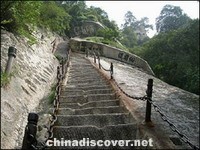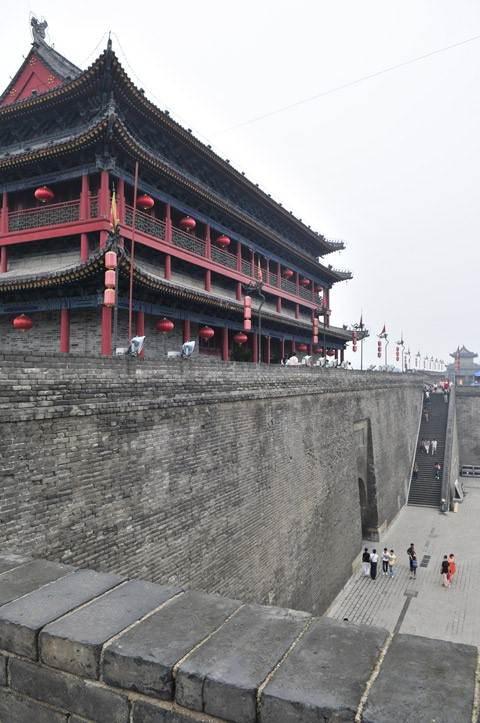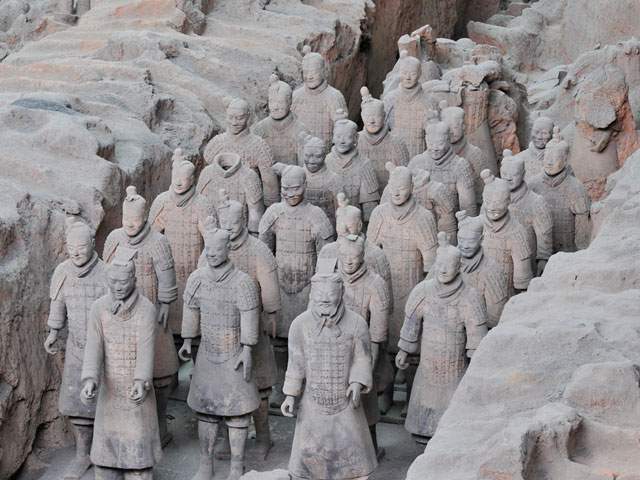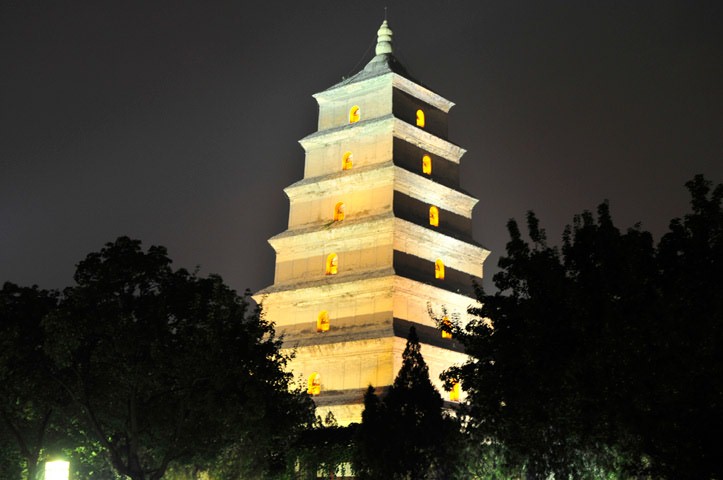Huashan Mountain

Huashan Mountain takes its name after its shape - a lotus flower with five petals.
The five peaks of Huashan Mountain have vivid names. The south one is called the Peak of the Wild Geese (Luo Yan Feng), the east one, the Peak of the Rising Sun (Zhao Yang Feng), the west one, the peak of Lotus (Lian Hua Feng), the Central one, the Peak of the Jade Maiden (Yu Nu Feng) and the north one, the Peak of the Cloud Terrace (Yun Tai Feng).
The route to conquer the peaks passes by temples, shrines, pavilions, terraces, carvings, statues, food stalls and hawkers, that appear interspersed between the stark granite paths and forested margins.
Taoism Temples
The south peak is the main peak and also the steepest of Huashan. Legend has it that Laozi, the originator of Taoism, used to missionize here. Among the many temples, the Jintian Palace, the Zhenyue Palace and the Chunyang Temple are the listed among the state-level Taoist structures.
Green Cloud Temple
The Green Cloud Temple is also called the Holy Mother Temple. It enshrines statues of three holy mothers. There is a large stone cut into three parts outside. It is the well-known "Axe Cutting Stone" for it looks as if it is being cut by an axe. Beside the stone, there is a huge axe. According to legend Baolian Deng (The Lotus Lantern), it was used by Chen Xiang to save his mother.
Jade Maiden Shrine
It is on the central peak of Huashan and stands on a natural stone tortoise. The Jade maiden was said to be Nong Yu -- daughter of Duke Mu of the Qin Dynasty (221-206BC). The story took place in the Spring and Autumn Period (770-476BC): A young man named Xiao Shi was good at playing bamboo flute. Nong Yu, who fell deeply in love with the poor young man, gave up all her nabobism to marry Xiao. The lovers came to Huashan and lived here for the rest of their life. To commemorate the couple, people built the Jade Maiden Shrine.
18 Bends
The Northern Peak, also called the Cloud Terrace Summit, is the first one you will have to confront on an assault on the mountain. Although the smallest of the peaks here, it still provides a great challenge to climbers due to its devilish precipitousness. There is only one path on the ridge that winds to the south, a place that is notoriously easy to defend. The route starts from near the Jade Fountain Temple (Yuchuan si) and follows a winding path called locally the "18 bends". After a slightly strenuous 3-4 hour climb you will arrive at the first peak, which is also home to the Zhenwu Taoist Temple (Zhenwu gong), a religious complex with a unique layout.
The 12km pathway leads from the foot of the mountain to the south starts at the Jade Fountain Temple (Yu Quan Yuan). It doesn't become precipitous until Qing Ke Ping , where there is a huge rock engraved with Chinese characters meaning? the point where the horses turn back?!. It warns that the challenges ahead and those who are not well prepared both mentally and physically should retreat.
Continuing the climb, one will be confronted with the Thousand-foot Precipice (Qian Chi Zhuang). It is a steep stone staircase, excavated on the cliff, rising vertically about 370 steps up to the North Peak . It's the first, but a great test of one's determination when the climbers proceed upwards supported only by iron chains on the flanks.
Following the Thousand-food Precipice , the pathway winds through rugged places such as the Hundred-food Valley (Bai Chi Xia), the Immortals' Bridge (Xian Ren Qiao), the God's Palm (Xian Zhang), and the Ear Touching Cliff (Ca Er Yan) where the path is so narrow that people have to pass with their ears touching the cliff.
Before reaching the summit of the North Peak, the climbers have to clear another staircase of over 500 steps, which is called Lao Jun's Furrow (Lao Jun Li Gou). The legend goes that Laozi, the originator of Taoism, made stairs on the cliff with his buffalo when he settled in Huashan after retiring.
Losing Chess Pavilion
The Eastern Peak is also known as the Sunrise Peak due to its acclaim as the best place for watching the rising or setting sun, as it dips below or rises from the usual sea of cloud. The attractions here, like those on the Southern Peak, are mostly Taoist influenced. Of the best include a statue of the one-time mentor of Laozi, called Chengtuan, in the Sanmao Cave (Sanmao Dong) and the Losing Chess Pavilion (Shuqi Ting) that houses an iron chessboard. Legend has it that Chengtuan once had a game with the first emperor of the Northern Song Dynasty (960-1127 AD), winning the whole of Huashan from the emperor's stake.
The path from the North Peak to the south is more exciting for daredevils. The Immortal Needle (Xian Ren Bian), the Heaven's Ladder (Tian Ti) and the Yama's Needle (Yan Wang Bian) dramatically speed up the climber's heart, but the worst is still to come.
Passing the Yama's Needle , the climbers will find themselves at the entrance to a mountain ridge, the Black Dragon Ridge (Cang Long Ling). The path on the ridge is tens of meters long, but as narrow as about 2 feet. On either side of the path, there are fatal steep cliffs. The deep valleys are invisible under the sea of clouds. Fortunately, iron chains are set on both sides of the way helping protect the passengers' lives, but when you arrive at the other end of the ridge, you will still feel like being reborn.
Is the Black Dragon Ridge the most precipitous places in Huashan Mountain? No. According to the visitors, the Floating-in-the-air Road (Chang Kong Zhan) and the Somersault Cliff (Yao Zi Fan Shen) are the most frightening. Some people who have been there still have had nightmares about falling.
Despite all the dangers in the pathway, the scenery along the roadside is superb, worth the sweat and tears one may shed on the way.





